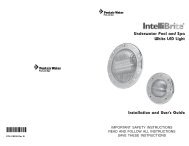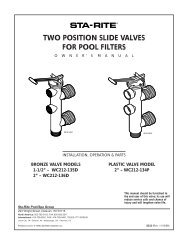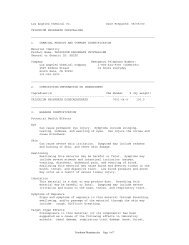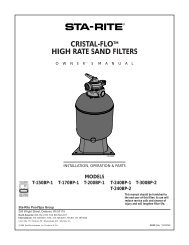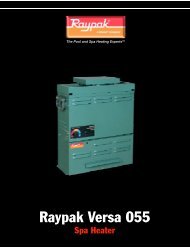Jandy LXi : installation and operation manual - Piscines et Spas ...
Jandy LXi : installation and operation manual - Piscines et Spas ...
Jandy LXi : installation and operation manual - Piscines et Spas ...
You also want an ePaper? Increase the reach of your titles
YUMPU automatically turns print PDFs into web optimized ePapers that Google loves.
Page 48<strong>LXi</strong> Pool/Spa Heater Installation <strong>and</strong> Operation Manual10.5.3.7 Gas Valve VoltageThe gas valve will operate only when there is acall for heat, all saf<strong>et</strong>y circuits have been satisfied, <strong>and</strong>the hot surface igniter has had power for appoximately35 seconds. If the gas valve does not operate underthese conditions, check the voltage going to the gasvalve. Place one voltm<strong>et</strong>er lead in the two-pin connectoron the controller where the yellow wire is connected(test point 14). Touch the free lead of the m<strong>et</strong>erto the gas valve terminal where the brown wire isattached at the gas valve. This test point will have voltagepresent only during a trial for ignition or duringnormal <strong>operation</strong>. The m<strong>et</strong>er should read 20-28 VoltsAC. If there is no voltage, then there is a bad connectionb<strong>et</strong>ween the gas valve <strong>and</strong> the ignition control.Replace the wire harness.Listen closely to the gas valve when it is firstenergized (24V first appears at test point 13 duringthe trial for ignition). There should an audible “click”when the valve opens.If there is voltage at the gas valve terminal wher<strong>et</strong>he brown wire is attached, but the gas valve does notopen, replace the valve.10.5.3.8 Igniter/Ignition Control CircuitWARNINGThe igniter, power supply circuit board <strong>and</strong> som<strong>et</strong>erminals of the ignition control utilize 120V or 240Vpower <strong>and</strong> require appropriate servicing precautions.Note that wires <strong>and</strong> terminals of these componentsmay be “hot” even when the component is notoperating.AVERTISSEMENTLe dispositif d’allumage, le circuit d’alimentationélectrique <strong>et</strong> certaines bornes de la comm<strong>and</strong>ed’allumage utilisent une tension de 120 V ou de 240V <strong>et</strong> exigent des précautions appropriées lors duservice d’entr<strong>et</strong>ien <strong>et</strong> de réparation. Notez que lesfi ls <strong>et</strong> les bornes de ces composants peuvent êtrechauds même si le composant ne fonctionne pas.47 seconds there is voltage b<strong>et</strong>ween test point J <strong>and</strong>test point K. If satisfactory ignition is not achieved,the igniter is turned off <strong>and</strong> the system waits for a 15second inter-purge period. The system may go throughthis cycle as many as three (3) times, but thereafter itis “locked out” by the ignition control for a 1 hour period.Additional attempts will be made only if the callfor heat is interrupted by turning off electrical poweror s<strong>et</strong>ting the control to “Off” <strong>and</strong> then back to "Pool"or "Spa" or after the one hour delay.To trouble shoot the ignition control's ignitercircuit, connect the voltm<strong>et</strong>er leads at test points J <strong>and</strong>K, <strong>and</strong> s<strong>et</strong> the control to call for heat. Observe thatthe normal ignition sequence takes place. After the15 second pre-purge, note the voltage b<strong>et</strong>ween testpoints J <strong>and</strong> K. Then look for the glow of the igniterthrough the view port on the right side of the combustionchamber. If the correct voltage is d<strong>et</strong>ected b<strong>et</strong>weenpoints J <strong>and</strong> K during the trial for ignition butthe igniter does not glow, check the connections to theigniter.Check the igniter with the ohmm<strong>et</strong>er. Disconnectthe IGN120 <strong>and</strong> IGNFS terminals from the ignitioncontrol. Place one lead of the m<strong>et</strong>er on each wire to theigniter. The resistance should read b<strong>et</strong>ween 40 <strong>and</strong> 75Ohms at ambient air temperature.If the m<strong>et</strong>er reading is outside of this range orshows an open or short circuit, replace the igniter. If ashort circuit is indicated, it is necessary to investigatefurther to find if the short is from the igniter or theflame sense circuit. Remove the air plenum cover <strong>and</strong>test the igniter resistance at test points H <strong>and</strong> I. If ashort is indicated, replace the igniter. If not, look forthe short in the flame sense circuit. Correct the short<strong>and</strong> replace any damaged wiring <strong>and</strong> the flame rod ifnecessary.If voltage does not appear b<strong>et</strong>ween points J <strong>and</strong>K during the trial for ignition, there may be a bad connection,faulty transformer, or a short on the ignitioncontrol. Check all connections, the transformer, <strong>and</strong>the ignition control for loose or corroded connectionsor failure <strong>and</strong> replace as necessary.With the igniter energized, there will be voltageof 102-132 VAC b<strong>et</strong>ween the IGN120 <strong>and</strong> IGNFSterminals on the ignition control, test point J <strong>and</strong> testpoint K, if the heater is connected to a 120V supply.If the heater is connected to a 240V supply, thenthe voltage reading b<strong>et</strong>ween these two points will be102-132 VAC if the transformer is working properly.This voltage will be applied only during igniter heat upor trial for ignition. Even if voltage has been confirmedat the end of the saf<strong>et</strong>y circuit, the “trial for ignition”sequence is imposed by the ignition control.This sequence consists of a 15-second period ofpre-purge, a 40-second period for heat-up of the igniter,<strong>and</strong> a 7-second trial for ignition. During this last






